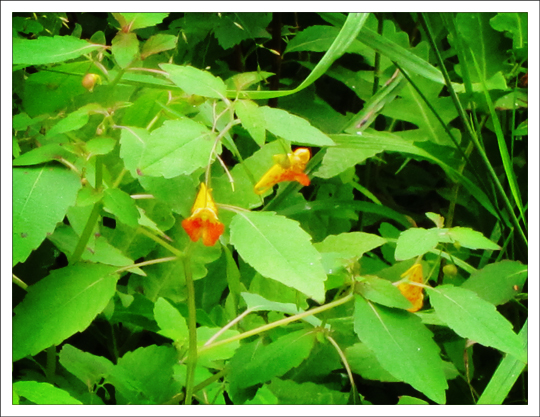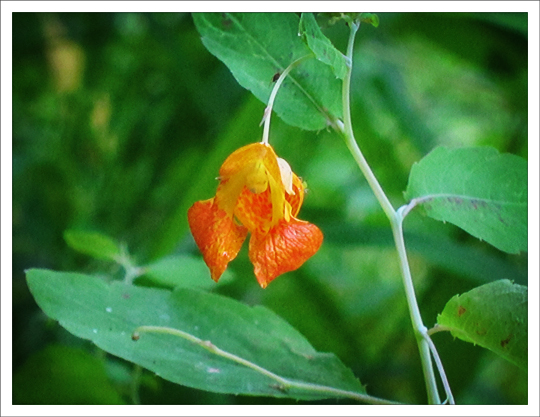Adirondack Wildflowers:
Spotted Touch-Me-Not
(Impatiens capensis)
 Adirondack Wildflowers: Spotted Touch-Me-Not on the Jenkins Mountain Trail at the Paul Smiths VIC (27 July 2011)
Adirondack Wildflowers: Spotted Touch-Me-Not on the Jenkins Mountain Trail at the Paul Smiths VIC (27 July 2011)
| This page is no longer being updated. For an updated and expanded version of this material, see: Spotted Touch-Me-Not (Impatiens capensis) |
Spotted Touch-Me-Not is an Adirondack wildflower that occurs in moist and wet areas in woods, swamps, beaver marshes and floodplains throughout the Adirondack Mountains and the north woods region. The plant grows up to five feet tall and has pale green, translucent stems. The succulent stems exude juice when broken. The orange flowers, which appear in July and August, hang on dangling stalks in clusters. Each flower is about one inch long and has deep orange to reddish spots. The fruits are pale green pods which "explode" at the slightest touch, scattering the seeds. The name "Touch-me-not" is derived from this characteristic. The plant is also known as Jewelweed and Orange Jewelweed - a reference to the way the spotted blossoms hand like a pendent jewel.
This species is an important source of food for the Ruby-throated Hummingbird, which reportedly contributes to its pollination. Bees and butterflies are also important pollinators.
Spotted Touch-Me-Not occurs from Alaska southwards through most of the Canadian provinces and into the eastern two-thirds of the continental U.S.
Spotted Touch-Me-Not was used as a medicinal herb by several native North American Indian tribes, particularly as an external application for wounds and skin complaints. The juice of the leaves reportedly can be used externally in the treatment of poison ivy rashes, nettle strings, and burns. There is contradictory reporting on the plant's edibility. Some reports indicate that the succulent stems can be cut up and cooked like green beans, while others warn that the plant is dangerous if ingested. The berries, in particular, are said to be toxic to humans.
 Adirondack Wildflowers: Spotted Touch-Me-Not on the Black Pond Trail at the Paul Smiths VIC (16 August 2012)
Adirondack Wildflowers: Spotted Touch-Me-Not on the Black Pond Trail at the Paul Smiths VIC (16 August 2012)
Spotted Touch-Me-Not is found on several of the trails at the Paul Smiths VIC, including the Jenkins Mountain Trail, the Black Pond Trail, the Heron Marsh Trail, and the Barnum Brook Trail. Spotted Touch-Me-Not usually blooms at the Paul Smiths VIC in late July and August.
References
- Lady Bird Johnson Wildflower Center. Native Plant Database.
- United States Department of Agriculture. Plants Database.
- University of Michigan. Native American Ethnobotany. A Database of Foods, Drugs, Dyes and Fibers of Native American Peoples, Derived from Plants.
- New York Flora Association. New York Flora Atlas.
- The New York Botanical Garden. The C. V. Starr Virtual Herbarium.
- NatureServe Explorer. Online Encyclopedia of Life.
- Plants for a Future. Database.
- Doug Ladd. North Woods Wildflowers (Falcon Publishing, 2001), p. 118.
- Lawrence Newcomb. Newcomb's Wildflower Guide (Little Brown and Company, 1977), pp. 54-55.
- Roger Tory Peterson and Margaret McKenny. A Field Guide to Wildflowers. Northeastern and North-central North America (Houghton Mifflin Company, 1968) pp. 208-209.
- National Audubon Society. Field Guide to Wildflowers. Eastern Region. (Alfred A. Knopf, 2001), pp. 424-425.
- William K. Chapman, et al. Wildflowers of New York in Color (Syracuse University Press, 1998), pp. 100-101.
- Donald D. Cox. A Naturalist's Guide to Wetland Plants. An Ecology for Eastern North America (Syracuse University Press, 2002), p. 55, 114, 130.
- Meiyin Wu and Dennis Kalma. Wetland Plants of the Adirondacks. Herbaceous Plants and Aquatic Plants (Trafford Publishing, 2010), p. 70.
